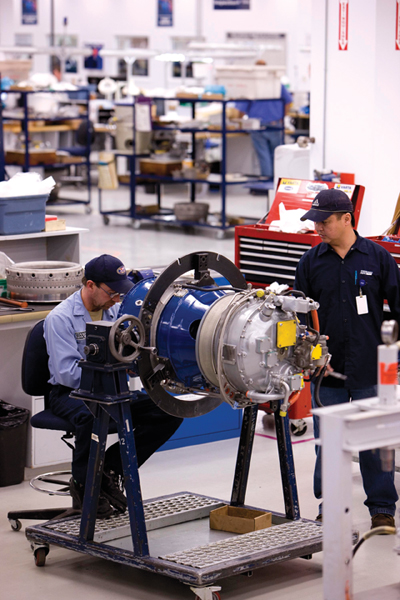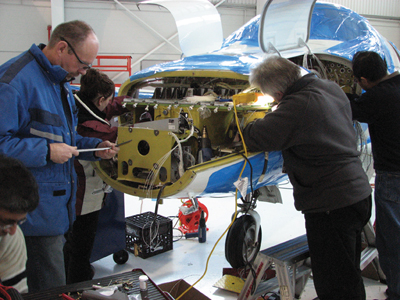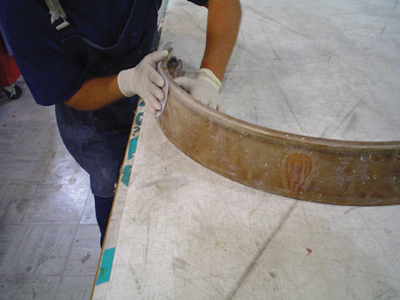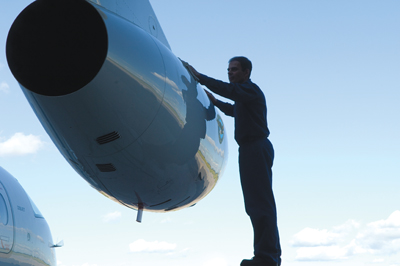
Features
MRO
Weathering the recession
Canadian MRO companies have been just as battered by the global recession as everyone else. But just how bad is it for these companies? “We are seeing a significant decline in sales in the AMO side of the business, and our manufacturing activity has all but ceased,”
September 29, 2009 By James Careless
Canadian MRO companies have been just as battered by the global recession as everyone else. But just how bad is it for these companies? “We are seeing a significant decline in sales in the AMO side of the business, and our manufacturing activity has all but ceased,” says Barry Aylward, owner of Kitchener Aero in Breslau, Ont. (at the Region of Waterloo International Airport). Things are somewhat better for Advanced Composite Structures (ACS) in Winnipeg. “[The recession] hasn’t had a big effect,” says ACS President James E. Anning, “although our customers’ requirements for service are reduced from prior years.”
 |
|
“Although the recession has impacted StandardAero, that impact has been diluted across the breadth of our company,” says Ian Smart, the company’s SVP Airlines and Fleets and Winnipeg Site Leader. “Our drive to diversify across numerous products in multiple market sectors, such as airlines and fleets, business aviation, government and military, and energy, has enabled us to manage our portfolio to minimize this recession’s impact.”
Dave McGrath, director of marketing and communications at Vector Aerospace, says his company is holding its own. “Things are going relatively well at Vector,” he explains. “The economy is lean as we all know, but we are still seeing a steady flow of work.”
Even the largest of companies have suffered from the economic downturn, such as Pratt & Whitney Canada (P&WC). “Like many of our customers who are being affected by the downturn and who have experienced production reductions, order deferrals and layoffs, we were also compelled to adjust our workforce, in line with our current and projected business activity – as announced earlier this year in February,” says Maria Mandato, P&WC’s senior communications advisor. “This reduction affected approximately 1,000 of our global workforce. This was not an easy decision. We are fully aware of the personal impact it has had on those affected employees.”
What’s Slow
One thing is certain: Segments of the MRO market have slowed down due to the recession. At StandardAero, “The most hard hit market sector has been business aviation, which has seen significantly reduced flying hours and aircraft being parked,” Smart says. “With the decreased revenues that have resulted from reduced flying, StandardAero has had to use the flexibility of our resources to best match market demands.”
At Kitchener Aero, “Both sales and our wire-harness manufacturing businesses are tough at this point, says Aylward. “Corporate aviation has really taken it on the chin through this downturn.”
Over at P&WC, it is the decline in corporate jets that are hurting sales: “Flying hours are down and new engine orders are being revised following production reductions by several OEMs,” Mandato says. “Overall engine shipments are expected to decline double digit in 2009.”
Nevertheless, there is a tradeoff in the marketplace that has helped mitigate some of the impact. “Instead of buying new aircraft, some operators are making investments to extend the life of their current fleet,” says McGrath. That means more work for those specializing in repair and overhaul.
Impact
For Canadian MROs, reduced revenues means losing talented technicians who are now looking for work elsewhere, either because they are now unemployed or because they see “the writing on the wall.” As far as James Anning is concerned, ACS’ biggest challenge is “Retaining our highly trained technicians; keeping them busy during the slow times.”
 |
|
| At Kitchener Aero, avionics repair is steady and flightline maintenance is also relatively good.
|
Ironically, StandardAero is having the opposite problem, according to Ian Smart. “Our biggest challenge at this time is in training people,” he explains. “We have a growing CF34 facility and have recently signed up to be a Designated Fulfillment Center for CFM56. Both of these products require growth in the size of the facilities and the number of people required to support them. We expect to hire more than 250 new people in Winnipeg by 2012 in order to support these two products, and properly managing the training of all these new hires remains our greatest hurdle.”
To tackle this problem more effectively, StandardAero has partnered with Red River College to establish a Gas Turbine Targeted Engine entry-level program at the college. This course will give new StandardAero employees basic fundamental skills and knowledge along with targeted engine training.
Responding to Bad Times
The time-proven way for a company to survive a recession is to cut expenses to stay within its reduced revenues. This is precisely what P&WC has done by cutting 1,000 people worldwide, and the company is not alone in doing so. For instance, ACS has “adjusted our costs accordingly by re-assigning the staff to areas needed,” says Anning. “We are actively pursuing cost containment to ‘right-size’ the company to our current sales volumes,” Aylward adds.
“StandardAero has been able to leverage the diversity of our business and the breadth of products within single locations to manage and smooth out the impact that the recession has had,” Smart tells Wings. “We have been able to cross-train employees on various engine types and move them throughout the company to have them in the places where they are needed most. StandardAero’s management team has also taken prudent measures to manage expenses such as reducing travel and freezing wages.”
“Before reducing our workforce, P&WC already took a number of actions to reduce costs, including curtailing hiring activities, reducing service providers, introducing furlough/unpaid days and a summer shutdown period,” Mandato says. “We have also engaged in significant adjustments to our cost structure, re-deployed resources and re-aligned our budgets to focus on our priorities. Yet, given the continuous changes in the economy, we were compelled to do more to remain competitive in the marketplace.”
“There have been no layoffs at at Vector,” explains McGrath. The company has retained all of its current staff and up until recently was still hiring and training people at its Alabama facilility.
 |
|
| ACS has adjusted its costs by re-assigning staff to areas where they are most needed.
|
Some Good News
Even during a recession, some aspects of the market do well: at least better than others. This is just as true for Canadian MROs as it is for car makers and fast food joints. At Kitchener Aero, “Avionics repair is steady,” says Aylward. “Flightline maintenance is [also] reasonably steady.”
“Within StandardAero, specific products – such as the CF34 MRO facility – continue to see considerable growth due to the current phase in maintenance cycles,” says Smart. “These products are most impervious to the recession as they are tied to customers with reduced flexibility to adjust their flying schedules. Additionally, StandardAero is busy continuing to diversify our product base with the addition of such new programs as the CFM56 licence, and the King Air 200/B200-Series PT6A-52 engine STC.”
Looking Ahead to Better Times
Although staff at many Canadian MROs are feeling down about the current economy, they are by no means feeling defeated. Instead, their collective attitude appears to be to hang tough, cut costs where they can, and plan for the inevitable time when revenues pick up.
“Our industry is cyclical and we have lived through similar tough periods,” says Maria Mandato. “Each time we have emerged even stronger, with increased volume and market share.”
“We are optimistic about the future,” says James Anning “as there will always be a requirement for our composite repair services.”
 |
|
| P&WC expects to maintain its competitiveness through its diverse product and customer portfolio.
|
At StandardAero, the company is still planning for growth, recession notwithstanding. “We have recently undergone a number of changes through the expansion of our CF34 business from 55,000 square feet to 135,000 square feet, which was only recently completed,” says Ian Smart. “We plan to again grow that facility an additional 25,000 square feet as we implement the CFM56 program, signed in June. These expansions are part of StandardAero’s long-term strategy. The CFM56 licence is the first element in our plans and investment is moving the business forward. Entry into the large-fan MRO market signals robust growth and a strong future for StandardAero.”
McGrath explains that Vector Aerospace plans to be aggressive but strategic in its future growth. Last year, Vector Atlantic was appointed by Pratt & Whitney Canada as the Designated Overhaul Facility for its 307 and 308 turbofan engines and Vector Aerospace plans to unveil some new product lines in 2010.
Meanwhile, P&WC expects “to maintain our competitiveness through a diverse product and customer portfolio that includes business jets, helicopters and turboprops, and by pursuing our efforts to reduce our costs,” Mandato says. “At the same time, we will maintain our long-standing commitment to deliver the highest of quality to our customers.”
As for Kitchener Aero and ACS? The first company is planning “Some marketing initiatives, and also continuing to circle the wagons,” says Barry Aylward. “[We are] cautiously optimistic.” For its part, ACS is sitting tight: “[We have] no changes planned for the immediate future,” says James Anning.
The bottom line? As exemplified by these companies, Canada’s MROs are toughing out the current economic storm. In doing so, these MROs are buoyed by a determination to get back to growing once things improve … which they always do.